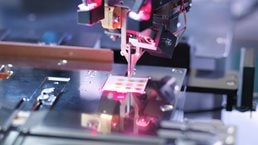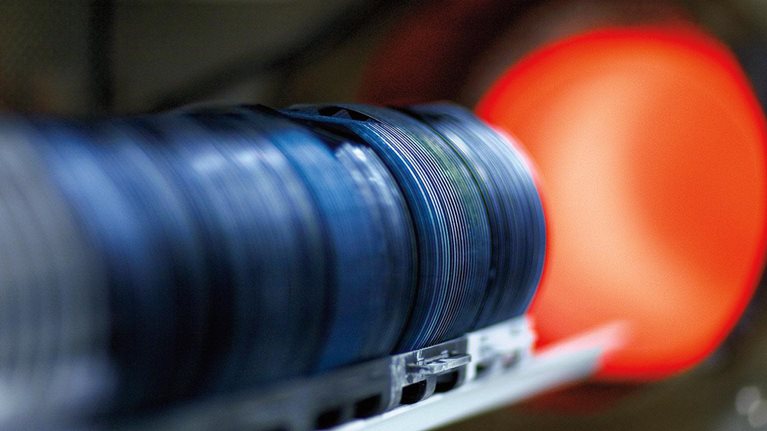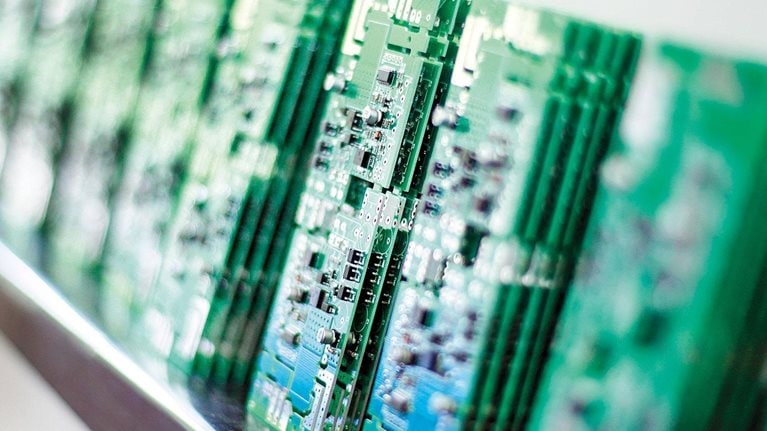The semiconductor market has grown by 4.6 percent annually over the past decade, with revenues rising from $213 billion in 2004 to $336 billion in 2014. This increase results from greater demand, primarily in the mobile segment, that is fueled by “shrink”—the ongoing decrease in the size of electronic components on silicon realized through continued process-node progression. Shrink enables both improved performance and reduced costs for end users.
Notably, one group of players has received limited benefits from the semiconductor industry’s gains: the capital-equipment companies that supply chip makers with machines for deposition, etching, lithography, metrology, assembly and testing, and other steps in the manufacturing process. Their revenues were volatile and only rose from $37 billion in 2004 to $38 billion in 2014—an increase of 0.1 percent annually. This is in contrast to the period from 1997 through 2004, when growth was 5.6 percent annually. While the semiconductor industry also saw lower growth over the past decade, its decline from preceding years was not as great. The steadily increasing growth discrepancy between chip makers and their suppliers is apparent when we make revenue comparisons. Revenues for equipment players were equal to about 18 percent of semiconductor-industry revenues in 1997; that figure fell to 11 percent in 2014 (Exhibit 1).

Despite these numbers, we see strong indications that the next decade will be more attractive for capital-equipment players. Growth in semiconductor demand is expected to remain steady, with device manufacturers and end customers continuing to favor leading-edge chips. Furthermore, the manufacture of these chips is rapidly becoming more advanced, and the number of fabrication layers is increasing. Semiconductor equipment plays a pivotal role in enabling the next generation of chips, providing new opportunities for capital-equipment manufacturers.
To increase the likelihood of success, equipment companies should build strong relationships with their customers, jointly working with them to solve technical challenges and promote innovation. In addition, they would benefit from defining a long-term strategy for dealing with one of the most important changes that will ever affect the semiconductor industry: the inevitable slowdown of Moore’s law. In a mature industry, semiconductor players will look for other means for continuing cost reduction and improving performance besides shrink and rapid time to market for new nodes, forcing equipment manufacturers to seek other forms of revenue and margin.
Growth drivers: The outlook for the equipment industry
Three forces will promote the capital-equipment sector’s growth over the next decade:
- megatrends that will continue to generate consumer demand for products containing leading-edge semiconductors, encouraging semiconductor players to invest in new fabrication capacity and equipment
- the increased determination of leading semiconductor giants to focus on innovation and develop cutting-edge products in response to intensifying competition and increased customer buying power
- a stronger role for equipment players as the process for moving to subsequent nodes becomes more complex, requiring both more equipment per wafer (due to an increasing number of process steps per wafer) and more expensive equipment (due to the increasing complexity of the equipment required to progress to subsequent nodes)
The first two forces—steady demand and a focus on innovation—have been present, to some degree, for many years, and they will continue to have a positive effect. But it is the stronger role for equipment players in the value chain that will open the most revenue opportunities in equipment sales and servicing in the next decade.
Megatrends may promote demand for leading-edge semiconductor products
A large ecosystem of companies with annual earnings before interest and taxes of more than $250 billion—both in the semiconductor industry and related sectors—is dependent on a continuous stream of new devices with increased performance, lower power consumption, and lower costs (Exhibit 2). We see several megatrends that could drive these companies to seek leading-edge chips:

- The mobile revolution. Smartphone penetration in developing markets is still at an early stage, and demand is expected to increase. Simultaneously, the creation of new mobile innovations, such as payment systems, will also lead to new demand in developed markets.
- The Internet of Things, connected cars, and advanced security. Several interrelated—some would say overlapping—areas could generate additional demand. Although the “things” will mostly be connected with chips based on mature nodes, the associated data and Internet connectivity will increase requirements for processing and storage capacity.
- Big data. Companies are increasingly analyzing the large stores of data that they accumulate to derive insights—for instance, greater knowledge of customer behavior. In consequence, data-processing and storage requirements are rising.
Together, these trends will continue to spur demand for leading-edge semiconductors. Equipment players like Applied Materials, ASML, KLA-Tencor, Lam Research, and others are well positioned to benefit from the increased demand.
Innovation will remain at the forefront of the semiconductor industry
Several forces are prompting semiconductor companies to remain at the forefront of innovation. First, leading high-tech players such as Apple have increasing influence over the semiconductor industry because of the scale of their orders. Semiconductor companies try to win their business by offering advanced technology, which increases the focus on innovation. Second, the semiconductor industry has been consolidating, and the remaining players are all determined to increase their market share. Traditional boundaries are also fading—for instance, microprocessor and logic segments are merging—so many companies are investigating new segments, as seen with Intel’s entry into the foundry market.
Such moves also increase competition, making it more important for semiconductor players to create technologically advanced products that will win market share.
Recognizing the importance of innovation, chip manufacturers will continue to invest heavily in R&D. We believe the economics of these investments are fundamentally sound, with the payback time for chip manufacturers remaining close to 24 months for nodes beyond 20 nanometers/16 nanometers (Exhibit 3). Equipment players may benefit from their customers’ focus on leading-edge technologies, as this will translate into demand for upgraded manufacturing technologies. Since these machines are more complex than those used over the past decade, equipment manufacturers will likely see increased sales.

A stronger role for equipment players
With shrink nearing its physical limits, technology road maps for reaching the next node are more complex and difficult than ever before. In consequence, we expect equipment players to have an even more pivotal role in the value chain as the key enablers of shrink, allowing them to increase their relative revenues in the semiconductor ecosystem.
First, the number of process steps per wafer is increasing, requiring more equipment, but the throughput of machinery is no longer increasing rapidly enough to compensate for this. Furthermore, a shift to 450-millimeter wafers, which would result in a step change in productivity for semiconductor manufacturers, is likely to occur later than expected or not at all, since cost advantages are declining for smaller nodes and required investments are enormous.
Second, the business model of equipment players is gradually shifting from selling hardware to selling a certain level of performance. Various equipment players are already offering different pay-per-usage models—for instance, by wafer or minute. Through these models, equipment players can extend their role in the fab and help semiconductor players optimize equipment performance for their specific processes and requirements.
The challenges ahead
Although the next decade opens opportunities for equipment manufacturers, we also see issues ahead. Consider some of the challenges that equipment players face:
- Competition is intense in each subsegment of the equipment market, with only the winners creating economic profit.
- The creation of more advanced technologies necessitates greater R&D costs for equipment, raising the stakes.
- Device architecture is less certain than it was in the past, with no clear winner among various design options. For instance, chip makers are investigating many new memory solutions for PC storage, such as 3-D NAND, HDD, MRAM, PRAM, and ReRAM. It is therefore often difficult to predict what equipment a semiconductor company will request.
- Chip makers tend to investigate several manufacturing options for every product, each with different implications for equipment manufacturers. They do not select the winning strategy until shortly before large-scale production begins, and their hesitation makes it difficult for equipment manufacturers to anticipate future demand, prepare their supply chain, and make their own technology-road-map choices.
- Equipment manufacturers must expand into new areas because of rapid advances in semiconductor components and production complexity—particularly the transition from 2-D to 3-D structure. For example, they need to create new equipment features to handle the increased atomic-layer deposition (ALD) and etching (ALE) that 3-D fabrication requires. Greater use of ALD and ALE will also require companies to hire more material scientists, because many new materials, such as silicon germanium and titanium, are now being used to advance semiconductor technology.
- With industry consolidation, many small semiconductor players have vanished, and the remaining larger players typically have more professional procurement operations with better negotiating skills. About 60 percent of equipment demand will come from six major semiconductor players, including Intel and Samsung. The scale of the remaining chip manufacturers will work in their favor, since equipment players eager to win large deals are often tempted to offer more beneficial terms.
Beyond these immediate problems, the slowdown of Moore’s law also presents challenges. There are indications that players are still striving for innovation, such as IBM’s recent surprise announcement of a 7-nanometer chip. Such developments make us believe that shrink will continue until at least 2025, as players strive toward 7-nanometer to 5-nanometer technology. That said, signs of a slowdown are already apparent and may become more pronounced over the next decade. For instance, Intel recently announced a delay in the development of its 10-nanometer node, which suggests that the company’s traditional two-year cadence for shrink has increased by at least six months. In a mature industry where the slowdown continues, semiconductor players will start to seek alternatives to both shrink and rapid time to market for reducing costs, forcing equipment manufacturers to search for other forms of revenue and margin.
Strategies for success
Given the shifts ahead, winning equipment players will employ a two-part approach: short-term strategies to promote innovation, handle complexity, and minimize risks, as well as long-term strategies to address the eventual slowdown of Moore’s law.
Winning in equipment over the next decade
Historically, only one or two equipment players has been successful in specific segments, and this trend continues. Today, a handful of companies—Applied Materials, ASM Pacific Technology, ASML, KLA-Tencor, and Lam Research—account for about 99 percent of all economic profit generated in the capital-equipment space (Exhibit 4). In this competitive market, the most successful players will focus on product excellence, develop innovative offerings, and collaborate with customers.

Product excellence. As technology challenges increase and R&D investments rise, the semiconductor industry’s winner-takes-all nature—which is already more pronounced than in other sectors—will become more intense. To succeed, equipment players should consider focusing on subsegments where they have established a leading position or can achieve one because their technology gives them an edge. We believe that expansions or acquisitions purely to increase scale or reduce cost are less likely to be successful in the current market. Players should consider entering other segments if this would reduce time to market or improve the value of their product offering. For instance, equipment players might gain an edge by collaborating with suppliers in related fields or acquiring them, since this will help them create an integrated supply chain. Such partnerships and acquisitions can help reduce lead times, which are increasing because of production complexity and uncertainty about when demand will accelerate.
Innovative offerings. Equipment players may also want to distinguish themselves from competitors through unique offerings. This strategy might involve several elements:
- providing integrated solutions and services, such as assisting with large-scale data analysis or software applications
- creating customer-specific solutions; since semiconductor players have their own unique manufacturing processes, there is an opportunity to tailor equipment to meet specific process requirements
- collaborating with other players to optimize the overall fab process; as one example, data exchange among equipment from different companies could promote improvement
Such efforts may require partnerships or M&A with other equipment players, since few companies will have all the skills needed to create these offerings.

Would you like to learn more about the Semiconductors Practice?
Customer collaboration. Closer collaboration with customers may be beneficial, since it otherwise would be difficult to develop solutions targeted to their specific needs. As an added benefit, customer collaboration could give equipment manufacturers more insight into any decisions made about device architecture or manufacturing processes.
Strategic partnerships with customers could also be important for certain equipment players, especially with R&D costs rising. For instance, equipment players could shift to a business model in which their customers provide sales guarantees, agree to a pay-per-use system, or cofund R&D projects related to equipment development, as Intel, Samsung, and Taiwan Semiconductor Manufacturing Company did with ASML. This strategy can increase the likelihood that an equipment player’s large investment in new technology will pay off.
The slowdown of Moore’s law will require a substantial strategic shift
When Moore’s law slows down significantly, demand for leading-edge equipment is predicted to drop precipitously. Since this change could present the greatest disruption that equipment manufacturers will ever face, they should begin preparing now, even though it is likely at least ten years away. For instance, equipment players could adopt a new business model in which more revenue comes from maintaining the installed base and optimizing its performance, rather than from selling new equipment. The transformation of pure hardware-oriented companies into those that are more service oriented has been observed in other maturing industries. Some companies have shifted from only creating parts—such as engines or wind turbines—to providing routine maintenance, repairs, and other services for existing equipment.
A new attitude toward cost reduction may also be beneficial as Moore’s law slows down. Traditionally, semiconductor companies have focused on reducing costs through shrink. Therefore, they prioritized decreasing time to market for the next node over the price of equipment. As the industry matures, however, fab costs will emerge as the main differentiator among semiconductor players. Equipment manufacturers may appeal to them by creating equipment that will help their customers minimize production costs.
Another strategy for securing long-term growth involves exploring opportunities to promote innovation in adjacent industries. This strategy will sometimes necessitate partnerships or M&A to gain market access. While a few equipment players have already begun exploring adjacent industries, results have been mixed. One success story involves Canon and Nikon, which drew on their knowledge of lithography for semiconductors to create lithography equipment for the manufacture of flat-panel displays used in various consumer goods, such as mobile phones, PCs, and televisions. Equipment players may be more likely to win in adjacent industries if they can leverage existing strengths, as companies in other sectors have done. For example, Fujifilm realized that it had to expand its core offerings as digital photography began to rise. Although the company began investing in digital technologies, it also started exploring other businesses where its thin-film and material capabilities would be useful. In one new business line, Fujifilm used its knowledge of photographic chemicals to create other chemical offerings, which it now supplies to multiple industries. Similarly, the company applied its knowledge of photographic technology to create medical-imaging equipment, such as endoscopes and ultrasound machines. Meanwhile, Eastman Kodak, Fujifilm’s main rival before the digital era, maintained its focus on the photography business and filed for bankruptcy in 2012.
Over the next decade, the end market for leading-edge devices containing semiconductors will continue to grow. To meet the demands of their customers for innovative products, semiconductor players will continue to strive for shrink. But they will face more challenges when attempting to realize their technology road maps, and the production process will become more complex. All of these trends could benefit capital-equipment manufacturers, provided that they focus on innovation, develop new strategies for sharing risk, improve supply chains, explore integrated solutions, and upgrade their sales capabilities. In addition to these strategies for short-term success, equipment players should also prepare for the eventual slowdown of Moore’s law and a mature industry by servicing the installed base, helping fabs reduce production costs, and exploring adjacent industries.


